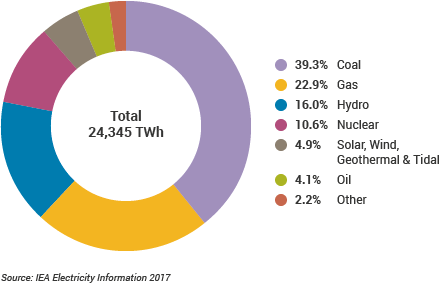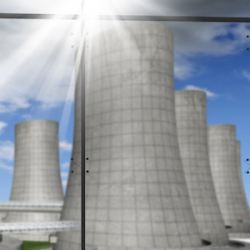It's repeated so often, that it's become conventional wisdom. To sustainably meet our energy needs, the world requires a balanced "energy mix" or an "all-of-the-above" strategy: a little solar power here, a little wind power there, and toss in some hydrothermal, geothermal, and natural gas for good measure.
That's nonsense, argues a new paper in the journal Sustainability. Instead of treating our energy policy like salad toppings at a buffet, let's just go full steam ahead on the one thing that could meet all of the world's energy needs right now: Nuclear power. The lead author, Barry Brook, is a nuclear power advocate and makes a compelling case centered around three major arguments.
The Laws of Physics
First, though many countries pay lip service to the wonders of renewable energy sources, solar, wind, geothermal, and tidal remain a paltry 4.9% of global electricity production, according to the World Nuclear Association. (See figure.) The reason, Dr. Brook and his co-authors argue, is not because of societal intransigence but "the undeniably diffuse and intermittent nature of the energy sources themselves" as well as "technological immaturity."
 The "diffuse and intermittent nature of the energy sources" is particularly problematic because they relate to the laws of physics. For multiple reasons, it is difficult to provide sufficient electricity to a dense urban area using only renewable sources. Neither does the sun shine nor the wind blow all day long.
The "diffuse and intermittent nature of the energy sources" is particularly problematic because they relate to the laws of physics. For multiple reasons, it is difficult to provide sufficient electricity to a dense urban area using only renewable sources. Neither does the sun shine nor the wind blow all day long.
Desert solar farms and coastline wind farms are not ideal solutions. Inevitably, power is lost when it is transmitted over long distances. Unlike food, energy is best generated locally. If local power is to be based solely on renewable sources, then massive technological breakthroughs, such as in solar panel efficiency and energy storage, will be mandatory. They may or may not happen.
Flawed Energy Models
Second, Dr. Brook points to the many flawed assumptions behind energy models. Many assume, without any acknowledgment of reality, that per capita power demand will decrease over time because of gains in energy efficiency. Perhaps that might be true in the distant future, but it's contrary to what we know now: As poor countries become more developed, they demand more electricity as cheaply as possible.
Energy models are also highly influenced by ideology and politics. How else can we explain the fact that energy models tend to minimize the implementation of nuclear power, the best energy source that mankind has exploited to date? Designing models that incorporate fantasy rather than reality is how Mark Jacobson concluded that the United States could be powered exclusively by wind, water, and solar by 2055. (As a side note, anyone who disagrees with Jacobson might be sued for $10 million.)
Huge Advances in Nuclear Technology
Third, nuclear technology has advanced to such an extent that the three biggest safety concerns (namely, radioactive waste, weapons proliferation, and accidents) have been largely solved. Dr. Brook is so bullish on one type of nuclear technology, called Integral Fast Reactors (IFRs), that he claims it "has been proven capable of eventually providing not just a slice of the energy pie but the whole pie." Why? He writes:
"The IFR can utilize nuclear waste and weapons-grade plutonium and uranium for fuel. A fleet of IFRs could consume both the spent nuclear fuel and the vast inventories of depleted uranium that have resulted from over half a century of nuclear power and weapons programs, for electricity and heat production. The IFR is ultimately capable of using over 99% of the potential energy in uranium and plutonium, via repeated recycling of the used fuel, which means that the existing material that we already have at our disposal could supply all the energy humanity is expected to require for many centuries..."
Fukushima-style accidents, in which a cooling failure led to a meltdown, are impossible with IFRs because the entire system has been fundamentally re-engineered. If an IFR nuclear power plant must shut down due to some emergency, it can do so without relying on external power or even human intervention.
Advances in engineering also lay to rest the criticism that nuclear power is too expensive. The components that make up some types of IFRs and other Generation IV nuclear plants are modular, which means they can be mass produced and shipped around the world.
Nuclear Power: Full Steam Ahead!
How quickly could the world be powered exclusively by nuclear, if it chose this path? As few as 25 years, according to an analysis previously published by Dr. Brook. We have the technological and financial wherewithal to do it; the only thing lacking is the political will. If climate change activists -- who are often the most vocal nuclear opponents -- are as serious as they say about the dangers posed by global warming, then they should jump aboard the atom wagon.
Energy policy really is that simple.
Source: Barry W. Brook, Tom Blees, Tom M. L. Wigley, and Sanghyun Hong. "Silver Buckshot or Bullet: Is a Future 'Energy Mix' Necessary?" Sustainability 10(2): 302. Published: 24-Jan-2018. doi: 10.3390/su10020302

